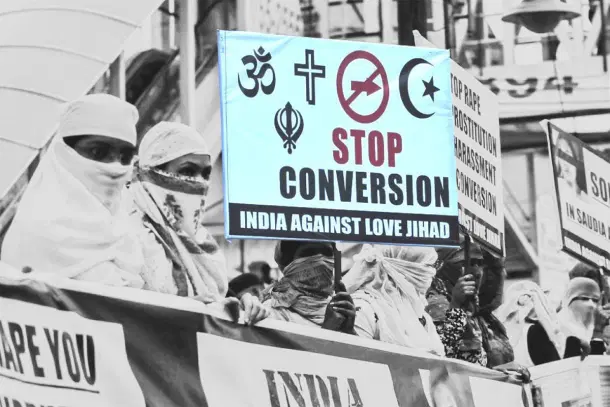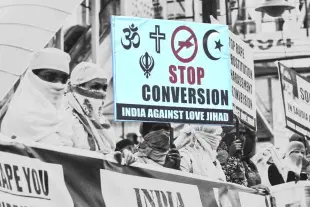Politics
Concern Over ‘Love Jihad’ Is Not Just Patriarchy; There’s A Deeper Reality
R Jagannathan
Jan 21, 2020, 12:43 PM | Updated 02:39 PM IST
Save & read from anywhere!
Bookmark stories for easy access on any device or the Swarajya app.


With every passing day, it is becoming impossible to ignore the reality surrounding 'love Jihad'. What we can perhaps dispense with is the pejorative nature of the term, but the phrase has caught on so well with the media that it is equally impossible to ignore its usage.
At least two organisations — the Syro-Malabar Church in Kerala and the National Commission of Minorities — have brought the issue to the fore. Earlier, when it was only some Hindu organisations making a fuss about it, it was seen as nothing more than a communal slogan.
Today, it is impossible to deny the reality, even if one can question how widespread it is. We need to have a rational discussion about the phenomenon, and commission some deep research so that the real truth is brought to light.
What we cannot do is bury the idea under political correctness, as a recent Times of India edit sought to do. In the editorial, the newspaper accused the Syro-Malabar Church of following the “Hindutva playbook” and thinking in a patriarchal way, where there is a “refusal to accept that in our free republic, adult female citizens are at liberty to fall in love with anyone they want.”
While one need not deny an element of patriarchal thinking behind the idea of ‘love jihad’, the truth is we tend to ignore many other things in the process. Take three example:
One, if, in an inter-faith marriage, there is an insistence on a nikah ceremony, can one claim that this is all about love and nothing else when a nikah presupposes religious conversion. And if we add the reality that apostasy is a bigger crime in Islam than in Hinduism, conversion may well be a one-way street. Whether this amounts to ‘love jihad’ or not may be a question of law, but the underlying reality is that conversion is partially forced by a marriage ritual or norm.
Two, last year the Supreme Court was hearing the complaint of a father whose daughter apparently married a Muslim who claimed to have converted to Hinduism on the basis of forged documents. After marriage, he apparently returned to his old faith. The problem here is that the love may be real, but the effort to misrepresent one’s faith before marriage can hardly be called noble or praiseworthy. Misrepresenting one’s identity in order to marry someone from another faith can easily be called a form of ‘love jihad’.
Three, when a non-Muslim woman marries a Muslim through a nikah, by definition she loses some of her earlier rights — right to divorce through the normal law, and defence against polygamy. The point is, can one avoid telling even inter-faith lovers of the implications of marrying under Muslim personal law? Otherwise, even normal love affairs take on the colour of a ‘love jihad’ — a one-way barter of rights by the non-Muslim woman.
At the social level, there is the larger reality of how Islam decides who is a Muslim. Nassim Nicholas Taleb, author of Skin in The Game, Fooled by Randomness, Black Swan, and Anti-Fragile, says Islam grows through demographic change brought on by the use of two asymmetric rules.
Writes Taleb: “The two asymmetric rules are as follows. First, under Islamic law, if a non-Muslim marries a Muslim woman, he needs to convert to Islam – and if either parent of the child happens to be Muslim, the child will be Muslim. Second, becoming Muslim is irreversible, as apostasy is the heaviest crime in the religion, sanctioned by the death penalty….”.
Given these asymmetric rules, Taleb points out, “one can do simple simulations and see how a small Islamic group occupying Christian (Coptic) Egypt can lead, over the centuries, to the Copts becoming a tiny minority. All one needs is a small rate of inter-faith marriages.”
The abductions of Hindu and Sikh women in Pakistan, and inter-faith marriages in Bangladesh, may partly be responsible for the rapid fall in the Hindu population as opposed to sheer migrations. One needs a study to establish why the Hindu population fell from 21 per cent in 1951 to 8 per cent in the last Census.
Using this reality in the Indian context, where many Hindu and now some Catholic groups are recognising ‘love jihad’ as a problem, this asymmetry needs to be discussed and debated openly. Both men and women need to be told clearly about the larger implications of inter-faith marriages. Love should prevail, but it should prevail against a backdrop where both parties fully understand the hidden rules that tilt the scales against non-Muslims.
At the very least, all nikah ceremonies in inter-faith marriages should be automatically covered under the Special Marriages Act, so that the woman is not unfairly handicapped by law later if the marriage goes wrong. This awareness building is not patriarchy.
‘Love jihad’ isn’t the problem; ignorance about the hidden rules surrounding it is. ‘Love jihad’ may be a needlessly pejorative term, but its underlying realities will not go away anytime soon.
Jagannathan is former Editorial Director, Swarajya. He tweets at @TheJaggi.





